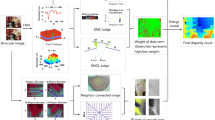Abstract
Most area-based approaches for stereo correspondence are leading to a large set of non-correct matches in the generated disparity-map. These are mainly caused by low textured areas, half occlusions, discontinuities in depth and the occurrence of repetitive patterns in the observed scene. This paper proposes a novel framework where non salient regions inside the stereo pair are identified previously to the matching, whereat the decision about the involvement of particular areas in the correspondence analysis is realized based on the fusion of separate confidence maps. They describe the possibility for a correct matching based on different criteria.
Preview
Unable to display preview. Download preview PDF.
Similar content being viewed by others
References
Hartley, R., And Zisserman, A.: Multiple view geometry in computer vision, 4th edn. Cambridge Univ. Press, Cambridge (2006)
Klette, R., Koschan, A., Schlüns, K.: Computer Vision: räumliche Information aus digitalen Bildern; mit 64 Übungsaufgaben. Braunschweig u.a.: Vieweg (1996)
Yuille, A.L., Poggio, T.: A Generalized Ordering Constraint for Stereo Correspondence. A.I. Memo 777 (1984)
Mayhew, J.E.W., Frisby, J.P.: Psychophysical and computational studies towards a theory of human stereopsis. Artificial Intelligence 17(1-3), 349–385 (1981)
Barnard, S.T., Fischler, M.A.: Computational Stereo. Computing surveys 14(4), 553–572 (1982)
Alvarez, L., Deriche, R., Sánchez, J., Weickert, J.: Dense disparity map estimation respecting image discontinuities: A PDE and scale-space based approach. Journal of Visual Communication and Image Representation 13(1-2), 3–21 (2002)
Brown, M.Z., Burschka, D., Hager, G.D.: Advances in computational stereo. IEEE Transactions on PAMI 25(8), 993–1008 (2003)
Tombari, F., Mattoccia, S., Stefano, L.D.: Segmentation-based adaptive support for accurate stereo correspondence (2007)
Mayoral, R., Lera, G., Perez Ilzarbe, M.J.: Evaluation of correspondence errors for stereo. IVC 24(12), 1288–1300 (2006)
HirschmüLler, H.: Improvements in real-time correlation-based stereo vision. In: Proceedings of Workshop on Stereo and Multi-Baseline Vision, Kauai, Hawaii, pp. 141–148 (December 2001)
JIANG, X, Lecture Notes for the module "Image analysis" at the University of Münster - Winter semester 2005/2006 (2005)
Anderson, B.L.: Stereovision: Beyond disparity computations. Trends in Cognitive Sciences 2(6), 214–222 (1998)
Anderson, B.L.: The role of partial occlusion in stereopsis. Nature 367(6461), 365–368 (1994)
Anderson, B.L., Nakayama, K.: Toward a general theory of stereopsis: Binocular matching, occluding contours, and fusion. Psychological Review 101(3), 414–445 (1994)
Yang, Q., Deng, Y., Tsang, X., Lin, X.: Occlusion handling in stereo imaging (2007)
Schmidt, J., Niemann, H.: Dense disparity maps in real-time with an application to augmented reality, pp. 225–230 (2002)
Laptev, I., Lindeberg, T.: Space-time interest points, pp. 432–439 (2003)
Wang, H., Ma, K.: Spatio-temporal video object segmentation via scale-adaptive 3D structure tensor. Eurasip Journal on Applied SP 2004(6), 798–813 (2004)
Kamiya, S., Kanazawa, Y.: Accurate image matching in scenes including repetitive patterns. In: Sommer, G., Klette, R. (eds.) RobVis 2008. LNCS, vol. 4931, pp. 165–176. Springer, Heidelberg (2008)
Roerdink, J.B.T.M., Meijster, A.: The watershed transform: definitions, algorithms and parallelization strategies. Fundamenta Informaticae 41(1-2), 187–228 (2000)
Comaniciu, D., Meer, P.: Mean shift: A robust approach toward feature space analysis. IEEE Transactions on PAMI 24(5), 603–619 (2002)
Christoudias, C.M., Georgescu, B., And Meer, P.: Synergism in low level vision, pp. 150–155 (2002)
Frank, A.: On Kuhn’s Hungarian Method - A tribute from Hungary. TR-2004-14. Budapest, Hungary: Egervary Research Group on combinational optimization (2004)
Scharstein, D., Szeliski, R.: A taxonomy and evaluation of dense two-frame stereo correspondence algorithms. International Journal of Computer Vision 47(1-3), 7–42 (2002)
Zabih, R., Woodfill, J.: Non-parametric Local Transforms for Computing Visual Correspondance. IEEE Transactions on PAMI (1994)
Bhat, D.N., Nayar, S.K.: Ordinal measures for image correspondence. IEEE Transactions on PAMI 20(4), 415–423 (1998)
Jähne, B., Haussecker, H.: Computer vision and applications: a guide for students and practitioners. Academic Press, San Diego (2000)
Siew, L.H., Hodgson, R.M., Wood, E.J.: Texture Measures for Carpet Wear Assessment. IEEE Transactions on PAMI 10(1), 92–105 (1988)
Bergmann, R., Nachlieli, H., Ruckenstein, G.: Detection of Textured Areas in Images Using a Disorganization Indicator Based on Component Counts. HPL-2005-175(R.1) (2007)
Feldman, D., Weinshall, D.: Motion segmentation and depth ordering using an occlusion detector. IEEE Transactions on PAMI 30(7), 1171–1185 (2008)
Author information
Authors and Affiliations
Editor information
Editors and Affiliations
Rights and permissions
Copyright information
© 2009 Springer-Verlag Berlin Heidelberg
About this paper
Cite this paper
Steffens, M., Aufderheide, D., Kieneke, S., Krybus, W., Kohring, C., Morton, D. (2009). Probabilistic Scene Analysis for Robust Stereo Correspondence. In: Kamel, M., Campilho, A. (eds) Image Analysis and Recognition. ICIAR 2009. Lecture Notes in Computer Science, vol 5627. Springer, Berlin, Heidelberg. https://doi.org/10.1007/978-3-642-02611-9_69
Download citation
DOI: https://doi.org/10.1007/978-3-642-02611-9_69
Publisher Name: Springer, Berlin, Heidelberg
Print ISBN: 978-3-642-02610-2
Online ISBN: 978-3-642-02611-9
eBook Packages: Computer ScienceComputer Science (R0)




